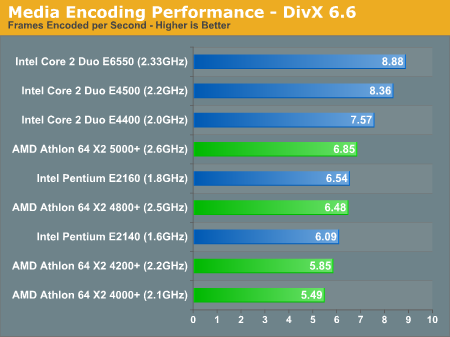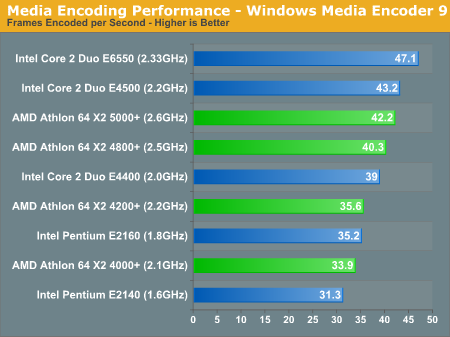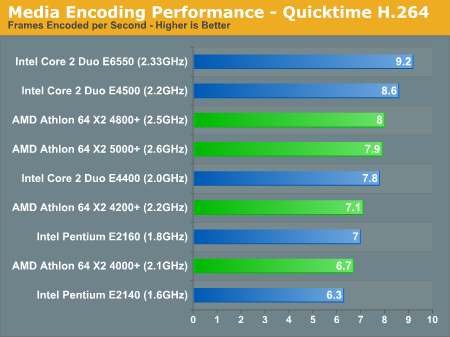Midrange CPU Roundup: It's Time to Buy
by Anand Lal Shimpi on September 28, 2007 2:00 AM EST- Posted in
- CPUs
Encoding Performance
Media encoding has finally reached the popularity it was predicted to be at years ago; the advent of portable media players and other devices that need transcoded content for proper playback has increased the role of media - in particular video - encoding on the desktop. Thankfully, even the slowest CPUs today can handle video encoding much better than they used to as little as a couple of years ago. You can thank having two cores on a single die for that.
Our DivX test uses version 6.6 of the codec alongside Xmpeg 5.0.3. We transcode an MPEG-2 file to DivX using an Unconstrained profile and a quality preset of 5. All other settings are left to their defaults and unlike our usual DivX test, enhanced multithreaded is left off since we're not dealing with any quad-core processors here.

DivX encoding performance is a clear win for Intel; the E4500 outpaces the X2 5000+ by over 20% and the E4400 is faster than its 4800+ competitor by 16%. Even the Pentium E2160 is a hair faster than the 4800+, and 19% faster than its price competitor: the 4000+. DivX performance is a particular strong point of the Core 2 architecture thanks to its significantly improved SSE engine. Worth note is that SSEn performance in general is one area where AMD's Phenom core will improve over the K8 that we're looking at now.
Windows Media Encoder has always been more evenly split between AMD and Intel, and we're seeing a perfect example of that here today. We encoded an MPEG-2 file to a WMV using the Windows Media Video Advanced Profile codec, with all settings left to their defaults.

The Core 2 Duo E4500 performs identically to the Athlon 64 X2 5000+, as do the 4800+ and E4400. The Pentium E2160 holds a slight advantage over the Athlon 64 X2 4000+ but it's nothing worth writing home about. As far as we can see, AMD and Intel offer the same price/performance in Windows Media encoding.
H.264 encoding is also becoming more popular thanks to its small file size at decent quality; for our QuickTime H.264 test we used the same source file as in the WME test and used QuickTime's default H.264 export settings.

The performance standings are pretty much identical to the WME test results, with the E4500 a bit ahead of the 5000+ but the rest of the contenders are in a close race.
MP3 Encoding is no longer the CPU hog that it once was when MP3s first burst onto the scene years ago, but at lower clock speeds ripping time can add up, especially if you're doing a lot of it. iTunes' MP3 encoder is multi-threaded and thus both cores are hard at work in this benchmark:

Intel takes the lead once more in the MP3 encoding tests. The E4500 outpaces the X2 5000+ by a significant 14% margin. Even the E4400 is faster than the 5000+, and the 4000+ is no match for Intel's Pentium E2160. Intel is a clear win here, and though we must admit that other MP3 encoders may not show the same results, iTunes' immense popularity make this an important benchmark.
Media encoding has finally reached the popularity it was predicted to be at years ago; the advent of portable media players and other devices that need transcoded content for proper playback has increased the role of media - in particular video - encoding on the desktop. Thankfully, even the slowest CPUs today can handle video encoding much better than they used to as little as a couple of years ago. You can thank having two cores on a single die for that.
Our DivX test uses version 6.6 of the codec alongside Xmpeg 5.0.3. We transcode an MPEG-2 file to DivX using an Unconstrained profile and a quality preset of 5. All other settings are left to their defaults and unlike our usual DivX test, enhanced multithreaded is left off since we're not dealing with any quad-core processors here.

DivX encoding performance is a clear win for Intel; the E4500 outpaces the X2 5000+ by over 20% and the E4400 is faster than its 4800+ competitor by 16%. Even the Pentium E2160 is a hair faster than the 4800+, and 19% faster than its price competitor: the 4000+. DivX performance is a particular strong point of the Core 2 architecture thanks to its significantly improved SSE engine. Worth note is that SSEn performance in general is one area where AMD's Phenom core will improve over the K8 that we're looking at now.
Windows Media Encoder has always been more evenly split between AMD and Intel, and we're seeing a perfect example of that here today. We encoded an MPEG-2 file to a WMV using the Windows Media Video Advanced Profile codec, with all settings left to their defaults.

The Core 2 Duo E4500 performs identically to the Athlon 64 X2 5000+, as do the 4800+ and E4400. The Pentium E2160 holds a slight advantage over the Athlon 64 X2 4000+ but it's nothing worth writing home about. As far as we can see, AMD and Intel offer the same price/performance in Windows Media encoding.
H.264 encoding is also becoming more popular thanks to its small file size at decent quality; for our QuickTime H.264 test we used the same source file as in the WME test and used QuickTime's default H.264 export settings.

The performance standings are pretty much identical to the WME test results, with the E4500 a bit ahead of the 5000+ but the rest of the contenders are in a close race.
MP3 Encoding is no longer the CPU hog that it once was when MP3s first burst onto the scene years ago, but at lower clock speeds ripping time can add up, especially if you're doing a lot of it. iTunes' MP3 encoder is multi-threaded and thus both cores are hard at work in this benchmark:

Intel takes the lead once more in the MP3 encoding tests. The E4500 outpaces the X2 5000+ by a significant 14% margin. Even the E4400 is faster than the 5000+, and the 4000+ is no match for Intel's Pentium E2160. Intel is a clear win here, and though we must admit that other MP3 encoders may not show the same results, iTunes' immense popularity make this an important benchmark.










44 Comments
View All Comments
Darth Farter - Friday, September 28, 2007 - link
why not the cool & quiet idle power numbers?seeing they're running at full speeds at idle is besides the point of an "idle" measurement in this age with powersavings...
tnx though on the bios update request from asus... I want to tweak my timings too.
Anand Lal Shimpi - Friday, September 28, 2007 - link
C&Q and EIST were both enabled for the idle and load power numbers. Actually all the benchmarks were run with those settings enabled.Take care,
Anand
archcommus - Friday, September 28, 2007 - link
I realize the benchmarks are run at 1024x768 to make the tests CPU-limited, does that mean all, or at least most, of the extra horsepower needed for resolutions above that comes from the GPU? If so, does that mean I could run games at 1280x1024 well with a high-end card and one of the AMD CPUs from this round-up? Or would that be a bad match-up? If that would work it's an appealing upgrade path alternative to jumping platforms.nosfe - Friday, September 28, 2007 - link
why not color code those performance graphs so that we can easily see which processors are competing at the same price